Drying figs is a great way to enjoy them all year long! Fresh figs are abundant during the summer months, but when winter hits, fresh figs are difficult to get your hands on! However, dehydrating figs is a simple process! They make for an excellent snack, can be used in baked goods, or as a natural sweetener.
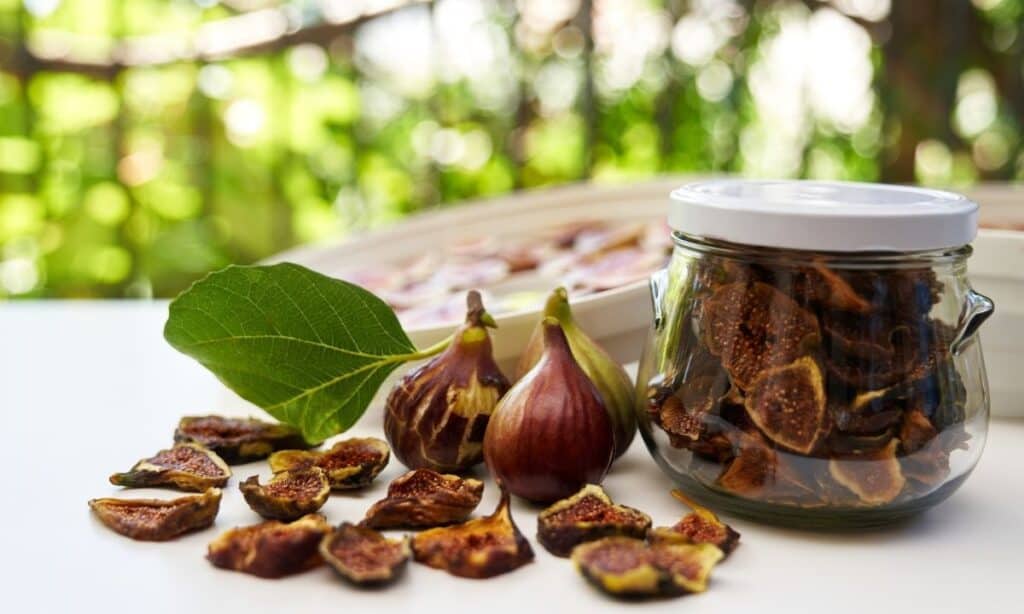
When it comes to snacking, fruit is my go-to! It’s naturally sweet and usually full of fiber which keeps me feeling full and satisfied.
Dried fruit is also a great snack, however, most dried fruit that you buy at the store is full of added sugar! In fact, some are even crystallized with sugar, making them more of a dessert than a healthy snack option.
When I discovered the easy way to dehydrate fruit at home, it was a total game changer! While fruit is in abundance during the summer months, when winter hits your choices for fresh fruit become limited. I usually end up stocking up on the basics including apples, citrus fruits, and bananas.
But what about those summer fruits you love? Do you have to wait a full year for summer to roll around to enjoy them again? No! You can dry your fruit so that it can be enjoyed for several weeks or even months. Drying your favorite summertime fruits makes them easily accessible all year long!
One of my ultimate favorite fresh fruits is figs! They have such a beautiful texture and sweet flavor! There are also numerous fig recipes you can use with these dried figs! Drying figs is a simple process. No sugar or extra ingredients are required!
Jump to:
Why This Recipe Works
- Only one ingredient
- No added sugar
- Two methods (dehydrator and oven)
- Simple technique
Ingredients
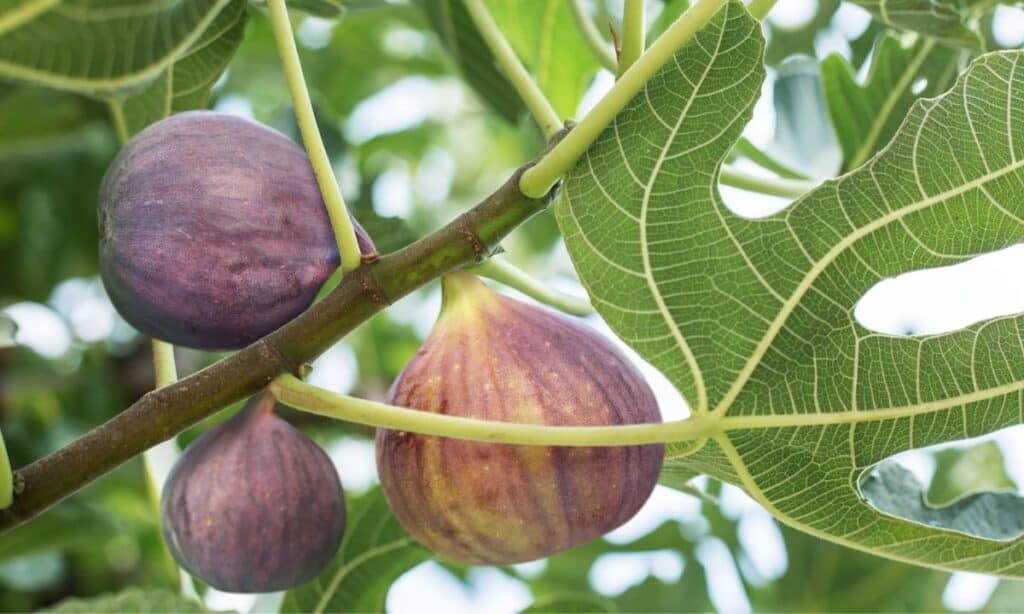
All you need for this recipe is fresh figs! They are a very sweet fruit. The inside is a pink-purple color. Fig season occurs twice a year. The first few weeks of June, and then again between August and October. The first season is known as “breba” and the second season is known as “new wood.”
Large fig trees grow in warm climates. They are most common in the Mediterranean. In the United States, most figs that are grown for commercial use are grown in California.
There are several different varieties of figs, but drying them works the same no matter what variety you use. Black Mission figs are the most popular followed by the Brown Turkey Fig, and the Green Kadota fig.
Ripe figs are slightly soft and have no breaks or blemishes on the skin.
Figs have excellent nutritional value! While they are one of the higher sugar fruits, they are rich in numerous vitamins and minerals and are particularly good sources of copper and vitamin B6. The drying process concentrates the sugars making them a sweet snack. Even though they are high in sugar, it is a natural sugar that is much better than the processed sugar you get from candy and sweets!
Tools and Equipment
The best way to prepare dried fruit is to use a food dehydrator. If you have a Ninja Foodi you can use that too as it has a dehydrate function. But you will need to make them in batches.

However, if you plan to dehydrate quite a bit of fruit I recommend using the Excalibur Dehydrator. It has 9 trays and 15 square feet of dehydrating space. It has a 26-hour timer and a variable temperature setting.
The traditional method of oven drying is another way you can prepare them. Directions for the oven drying method are also given.
How to Dehydrate Figs – Step by Step
Step 1: Wash the figs well and carefully. Figs can easily bruise. If you have one, use a vegetable scrubber to scrub off any coatings or chemicals that may be present.
Step 2: Bring a pot of water to a boil. Using a metal strainer, drop the figs into the boiling water for 30 seconds. Remove, and quickly place them in an ice bath with cold water. This helps to break down the skins and allows the figs to dehydrate more quickly.
Step 3: Pat them dry with a paper towel or clean dish rag. Remove the stems, and cut each fig into quarters.
Step 4: Place figs on the dehydrator trays in a single layer cut side up. Leave some space between each of them so that the air circulates evenly. If you prefer, you can leave them whole, or cut them in half.
Step 5: Set your dehydrator to the fruit setting, or to a temperature of 135 degrees F. Drying time will depend on how much moisture is in the figs themselves, the climate where you live, and whether you’re drying the figs quartered, halved, or whole.
- Quartered figs will be a minimum of 6 hours.
- Halved figs will be about 8 hours.
- Whole figs will likely be anywhere from 8-12 hours.
Check your figs at the 6-hour mark to gauge how much additional time is needed if any.
Step 6: Remove the figs from the tray and transfer them to a wire rack to cool to room temperature before transferring them to a glass jar or airtight container.
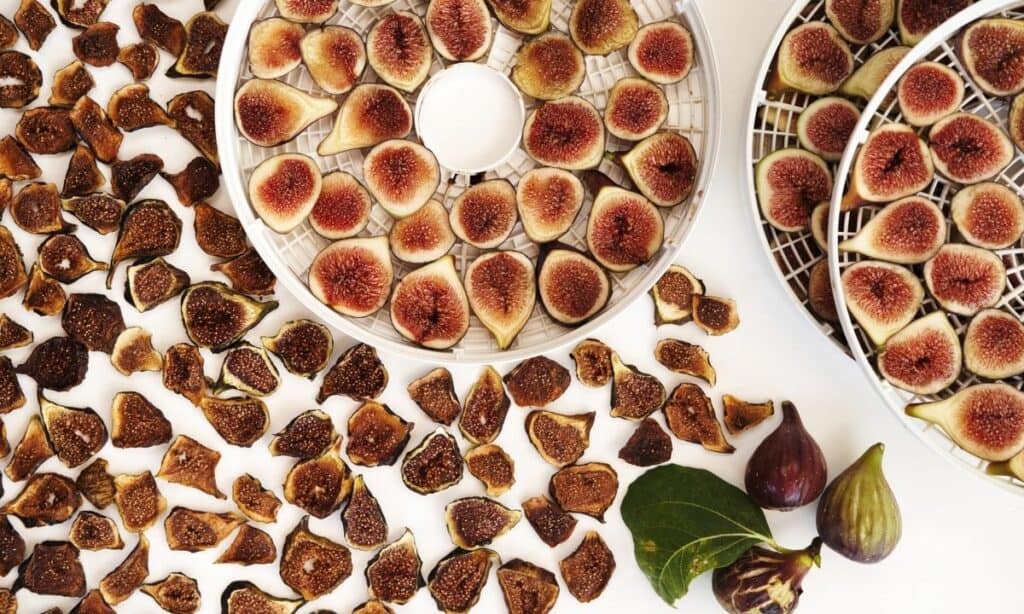
FAQS
Knowing when your figs are done depends on a few things. It should have a leathery look, a chewy texture, and be dry to the touch. In order to judge whether your figs are completely dried, remove one from the dehydrator, allow it to cool, and give it a taste test. It will take anywhere from 6-12 hours to dry in a dehydrator.
There are numerous storage methods including room temperature, refrigerator, and freezer.
Once the figs have cooled to room temperature, transfer them to an airtight container. I like to store my dried figs in a large mason jar. To increase the shelf time, place a food-grade oxygen absorber in the jar. Store them in a cool, dark place.
You can also store dried figs in the freezer. Place them in a freezer-safe plastic bag labeled with the date. They will keep for 12-18 months.
If you prefer, store them in the refrigerator. They will keep in the fridge for up to 2 months.
The smaller you cut the figs the longer they will last. Quartered figs, when kept in a cool dry place in a sealed container with an oxygen absorber will last for 1-2 years. Halved figs will last for a similar amount of time. If your figs are whole they will last for 1-2 months. This is because it is more difficult to remove all of the moisture from a whole fig than it is to remove the moisture from a quartered or halved fig. If you dehydrate whole figs check them for mold within the 1-2 month range to be sure they are safe to eat!
There are many ways to enjoy dried figs. You can eat them whole as a snack. Toss them in a salad for a bit of sweetness and texture. Chop them up and add them to your cookies or quick bread. Cook them into your morning bowl of oatmeal. Make a healthy trail mix with them. Really, anywhere you’d use dried fruit, is an opportunity to use dried figs.
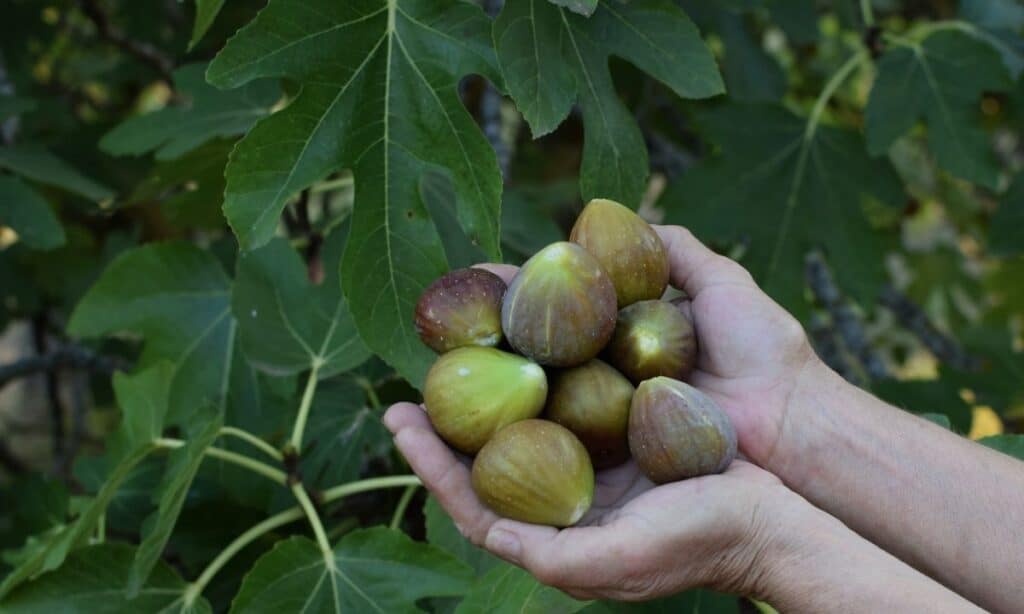
How to Dry Figs in an Oven
If you don’t have a dehydrator but would still like to dry figs, no problem! You can use your oven! This works especially well if you have a convection oven that evenly circulates air.
Follow the same steps you would for the dehydrator, gently wash, pat dry, and cut your figs into quarters.
Instead of placing your figs in a dehydrator, arrange them on a baking sheet lined with parchment paper. Spread them out to give space between each one. Place them in the oven at the lowest temperature, about 140 degrees F for 26-36 hours. It is recommended to keep the oven door slightly ajar.
Expert Tips
- If you have a dehydrator use it! I simply don’t like to have my oven running for such an extended period of time, plus I likely need it for other cooking projects!
- Placing the figs in boiling water helps to break down the skin without cooking them, ultimately helping them to dry more quickly. But if you’d like to skip this step, that is fine, just note that you may need to increase the dehydrating time.
- Using a food-grade oxygen absorber in the airtight container to lengthen the shelf life.
- The key to dehydrating fruit is to use a low temperature for an extended period of time.
- Do not store dried figs in a plastic bag! This will cause increased moisture. It’s a good idea to store the dried figs in a glass air-tight container.
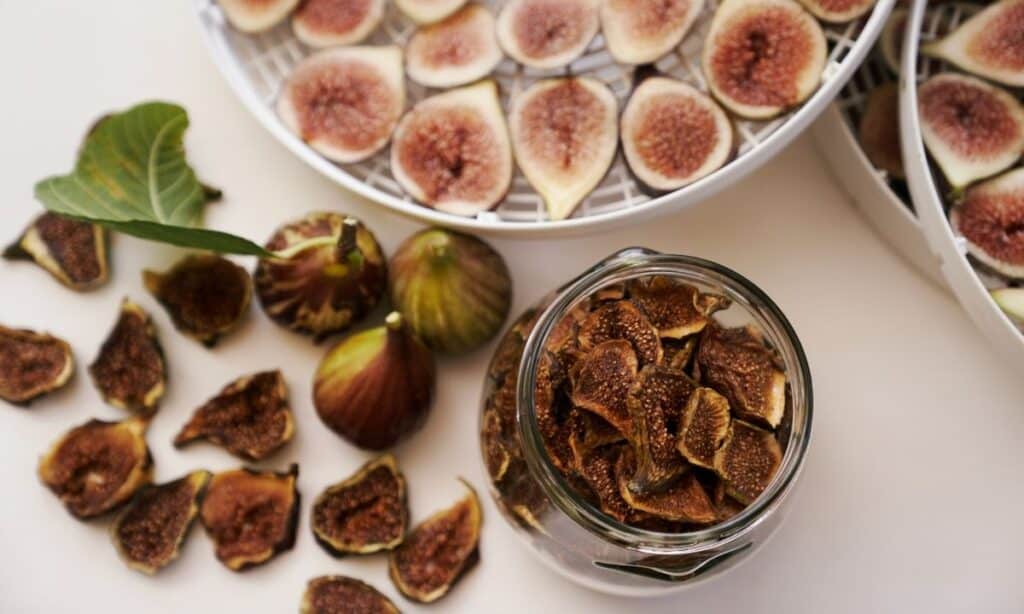
More healthy snack recipes!
Recipe Card
Recipe
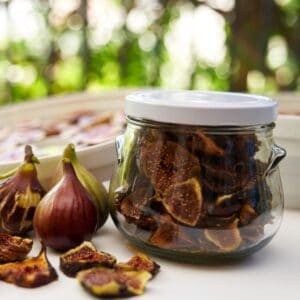
Drying Figs: How to Dehydrate Figs Two ways
Equipment
Ingredients
- 1 lb fresh figs
- water for boiling
Instructions
- Wash the figs well. While washing be careful and don't handle them too roughly. Figs can easily bruise.
- Bring a pot of water to a boil. Using a metal strainer, drop the figs into the boiling water for 30 seconds. Remove, and quickly place them in an ice bath. This helps to break down the skins and allows the figs to dehydrate more quickly.
- Remove the stems, and cut each fig into quarters.
- Arrange the quarters on your dehydrating trays. Leave some space between each of them so that the air circulates evenly. If you prefer, you can leave them whole, or cut them in half.
- Set your dehydrator to the "fruit" setting, or to a temperature of 135 degrees F. The time will depend on how much moisture is in the figs themselves, the climate where you live, and whether you drying the figs quartered, halved, or whole. See notes for how long you should keep the figs in the dehydrator.
- Remove the figs from the tray and transfer them to a cooling rack to cool to room temperature. Then transfer to an airtight container for storage.
Dehydrating in the Oven
- Follow steps 1-3 above.
- Arrange the figs on a baking sheet lined with parchment paper. Spread them out to give space between each one. Place in the oven at 140 degrees F for 26-36 hours.
- Remove the figs from the baking sheet and transfer them to a cooling rack to cool to room temperature. Then transfer them to an airtight container for storage.
Notes
- Quartered figs will be a minimum of 6 hours.
- Halved figs will be about 8 hours.
- Whole figs will likely be anywhere from 8-12 hours.
- Check the figs at the 6-hour mark to gauge how much additional time is needed if any.
- If you’d like to skip step 2 of dunking the figs in boiling water, and then transferring them to an ice bath, that is fine, but it may add time to the dehydrating process.
- Place a food-grade oxygen absorber pack into the storage container you use to increase the shelf life.
- Dry gigs will keep for 1-2 years if quartered or halved. They will keep for 1-2 months if dried whole.



Casey Markee
I love figs and for drying, this worked perfectly. Thanks!